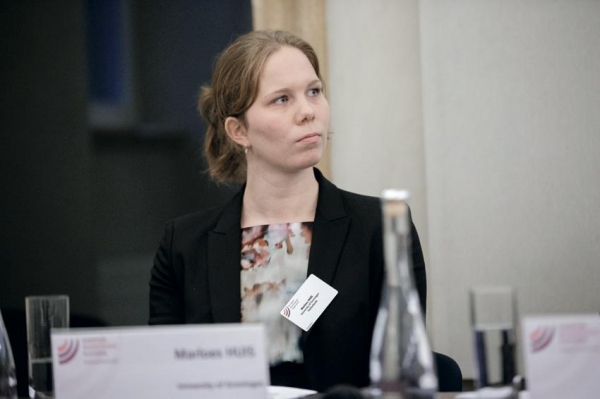Convenient products for inconvenient times: the role of financial services in conflict situations
- David BARTOCHA, GIZ
- Marloes HUIS, University of Groningen
- Sitara MERCHANT, Aga Khan Agency for Microfinance
- Thomas RAHN, GIZ Jordan
PRESENTATIONS
David BARTOCHA opened the session by stating that microfinance in conflict areas is getting increasingly important. The session aimed at answering the question of how the financial sector can operate in such areas.
Thomas RAHN from GIZ presented the actions of the regulator in the Palestinian case which made it possible to navigate the financial sector through political conflicts such as the Gaza War in July 2014. The Palestine Monetary Authority (PMA) takes several actions to increase the resilience of the financial sector. Firstly, the PMA takes pre-crisis measures. Continuous preparation takes place to ensure business continuity and financial preparedness during future crisis. Banks, for example, are prepared to provide alternative sites if necessary and go through scenario settings to test their reaction in crisis situations. Secondly, during a crisis the PMA assures a stable infrastructure and implementation of applicable crisis scenarios takes place. The PMA makes sure that banks have enough cash available to serve clients’ needs and maintain trust, coordinates opening hours and takes decisions whether justification is given for opening branches, provisions exemptions and loan rescheduling when necessary. Thirdly, post-crisis the regulator evaluates the crisis management in terms of financial inclusion, financial and physical infrastructure as well as internal communication of the PMA steering unit. Rahn concluded that a number of lessons can be learned from the Palestinian case.
Marloes HUIS, from the University of Groningen, presented results of a cross-sectional study by Nina Hansen and Marloes Huis researching the social impacts of access to microfinance services. The ProMIS program implemented by GIZ in Sri Lanka provides microfinance services through MFIs to marginalized people. The MFIs encourage saving, provide trainings and loans. Since 2009, 20,000 marginalized people have profited from access to microfinance services. The cross-sectional study among 480 marginalized individuals in four war-affected regions showed that the program had positive outputs in the treatment group. 67 percent of the clients saved money; 35 euros on average. 84 percent of the clients participated on average in 2.12 trainings and 45 percent of the clients used the received micro loan to expand economic activity, 41 percent to start a business. The impact assessment showed that the program also had positive higher order impact. Microfinance services combined with training increased the empowerment, financial and social integration as well as inclusion of marginalized people.
Sitara MERCHANT, from the Aga Khan Agency for Microfinance, introduced the SEEP / Citi Disaster Risk Reduction (DRR) Program as a member of the multi stakeholder steering committee. The program aims at bringing together a wide range of institutional actors to promote a common agenda around DRR for low income financial markets. Firstly, it aims at improving the resiliency of financial services providers and communities they serve. Secondly, the program focuses on creating awareness of the need for disaster preparedness, given the more frequent and severe crisis, and building consensus among key stakeholders around effective disaster risk reduction practices. Lastly, it aims to strengthen the capacities of financial service providers and their clients to anticipate, cope, and recover from the negative impacts of disasters. Initially, the DDR program secured funding for 1.5 years. The activities of the steering committee to date include: 1) a Kick-Off event September 28, 2015 in Washington DC; 2) Bilateral discussions with SC members to identify current initiatives for knowledge sharing; 3) Desk review of market mapping tools for DRR diagnostics of financial services market; and 4) Development of a country level framework for engagement to be pilot tested in India in 2016.
Merchant also shared her experiences from the work of Aga Khan Agency for Microfinance (AKAM) whose mission is to affect demonstrable, measurable, and lasting improvement in the quality of life of its clients by delivering appropriate financial services to diminish the vulnerability of the disadvantaged and enable economic and social inclusion. AKAM works closely with the other Aga Khan Development Network (AKDN) agencies as part of a coordinated approach that brings together many inputs and disciplines. Merchant shared two examples from AKAM’s financial institutions in Afghanistan, The First MicroFinance Bank Afghanistan (FMFB-A) and Syria, The First Microfinance Institution Syria (FMFI-S). The Afghanistan example illustrated the importance of building client resilience though a housing finance product that is coupled with Construction Appraisal and Advisory (CAA) in a country which is a seismic hot spot. FMFB-A has more than 55 thousand clients; with an outstanding portfolio of USD 61.5 million. The housing finance portfolio accounts for 15 percent of the total portfolio (USD 9.5 million) and 17 percent of clients (9.3 thousand). The Syria example illustrated how FMFI-S maintains its client centric focus, putting clients at the centre and structuring processes to meet their needs, which has mitigated institutional risks during the current crisis. Between 2011 and 2015, the cumulative loans disbursed added up to more than 74 thousand with a value of over USD 65 million. While FMFI-S’ sister agencies, Aga Khan Foundation and FOCUS Humanitarian, have distributed aid to more than 35 thousand households.
DISCUSSION

Rahn, when asked to provide other elements of financial sector resilience, mentioned the institution’s survival, the client’s survival – including the clients’ trust in the financial system, and the infrastructure between the financial institution and the client. Bartocha asked if, based on the Palestinian case, the conclusion could be drawn that good regulation is more important than the political situation. Rahn disagreed as a crisis situation is not only about regulation, but also about leadership and cooperation between actors. Lastly, there is no single concept that is applicable to all countries. The regulation of the financial sector is very costly in Palestine and this might not be appropriate for other countries.
Lot of quality choices thanks to a wide variety of interesting topics covered
